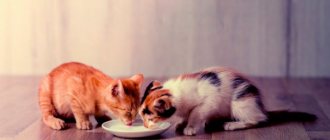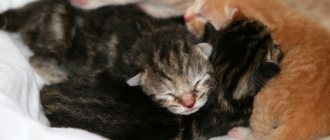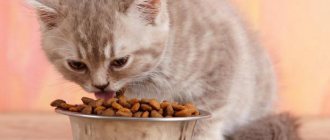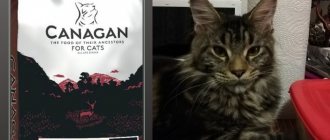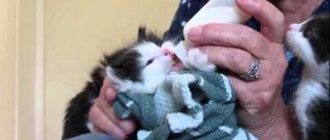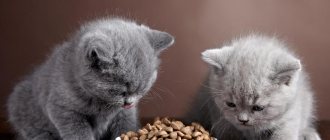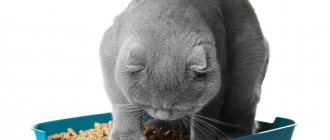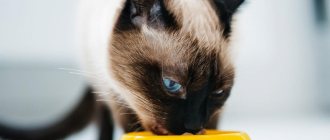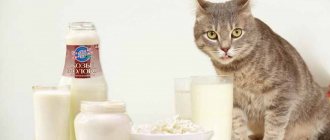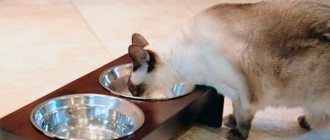Feeding mode
By 4-5 weeks, the kitten needs to develop a regular food intake routine. Feeding should be from 4 to 7 times a day, but these recommendations are average and can be adjusted up or down.
Recommended feeding frequency per day, depending on age:
- from 4 to 8 weeks – up to 7 times, night feeding should be avoided;
- from 8 to 12 weeks – up to 6 times;
- from 16 to 20 weeks – 5 times;
- from 5 to 9 months – 4 times;
- from 9 months to 1 year – three times a day.
A kitten over the age of 1 year should get used to eating twice a day with a mandatory 12-hour break.
Portions must meet the following sizes:
- from 4 to 6 weeks : 120 g of food per day;
- 8 weeks : from 160 to 180 g;
- from 12 weeks to 6 months : from 180 to 240 g, of which at least 40 g should be allocated to meat;
- 6-9 months : 180 g of food per day;
- from 10 months to 1 year : from 150 to 200 g.
You should at least approximately adhere to the amounts of food recommended by the veterinarian and the breeder. Overeating can cause major health problems in the future. An adult cat may develop obesity, pancreatitis, and diabetes.
Feeding standards
The amount of food per meal depends on its type and type of feeding. Veterinarians recommend keeping domestic cats on a natural diet, regularly using vitamin and mineral supplements, and following a two-time feeding regimen (morning and evening).
An adult healthy animal should be provided with at least 10 g of protein, 2 g of fat, 1 g of carbohydrates, 1 g of fiber per 1 kg of weight per day. The daily energy value for natural feeding should be at least 40 kcal per 1 kg of weight.
Diet of a one-week-old kitten
If the mother cat does not have enough milk or the kitten grows up without her, the owners should know what is allowed to feed such babies. During this period, the most important thing is not to spoil their stomach and provide the body with all the necessary useful components. Therefore, the menu of a seven-day kitten includes the following:
- 500 ml of high concentration milk and chicken yolk, raw;
- 2.5 g of dry yeast and 15 g of milk (only dry and whole), 50 g of whole cow's milk;
- beaten chicken protein and 1 hard-boiled egg, 4 g of sugar (grape) and 1 g of vegetable oil. oils;
- corn oil - half a teaspoon, 50 ml milk and 1/2 yolk.
When the baby reaches four weeks of age, you can gradually begin to feed him.
Can kittens have boiled meat?
Does a kitten need to cook meat? No no need. He, being a predator, does not need this. Yes, the kitten looks weak and fragile. But that's what you think until you put a piece of raw meat in front of him.
And, nevertheless, kittens can also have boiled meat, it is not poison. However, such nutrition has a number of disadvantages. Firstly, it, as we have already written, is almost completely devoid of useful substances. On a boiled diet, a kitten has to add special vitamin and mineral complexes to its food, which are expensive and often do more harm than good. Secondly, boiled meat is dehydrated, meaning that eating it in large quantities creates a risk of constipation. Thirdly, it is raw fiber that helps adjust the kitten’s digestive enzymes in the right way.
Well, if you only occasionally want to treat your cat to a piece of boiled meat, that’s okay. The main thing is that the basis of the diet is raw.
Authorized Products
Small animals allowed on the menu:
- Meat – served raw, boiled or scalded with boiling water. Only low-fat varieties are suitable. Meat products should make up from 60 to 80% of the total daily food intake.
- Liver – no more than 2 times a week.
- Porridges – any are suitable, except semolina. All kittens are not fans of cereals, but they contain many substances that the growing body needs. It is recommended to mix meat and porridge in a ratio of 2 to 1.
- Vegetables - any, except potatoes, served boiled or raw.
- Chicken eggs - small pets can only be given the yolk. Its consumption is also allowed in raw form, but not more than once every 7 days. The yolk of quail eggs can be consumed simultaneously with the white.
- Fermented milk products - any, but with a minimum percentage of fat content. The exception is sour cream; giving it to kittens is strictly prohibited.
- Oil – not vegetable oil, but Vaseline is recommended.
- Brewer's yeast - affects the coat of a small pet.
It is recommended to give your kitten an apple as a fruit.
Carbohydrates and fiber in natural foods
To replenish this important nutritional element and ensure high-quality digestion of food with a natural diet, raw, boiled, steamed vegetables, fruits and berries must be included in the cat’s diet.
Not all animals are attracted to the taste of apples, greens, cranberries, blueberries, legumes, and carrots. You can add a little sunflower or olive oil to this food, and also mix it with pieces of meat or puree.
Preference should be given to cauliflower, broccoli, lettuce, zucchini, pumpkin, and apples. But some vegetables are on the list of prohibited foods (more on that below) and are not recommended for cats. Oatmeal and pearl barley porridge can be included in the diet of pets. It is not recommended to give semolina porridge, i.e. wheat.
What is prohibited for a kitten
In order not to provoke complications in the functioning of the baby’s gastrointestinal tract, the following products should not be on the menu:
- freshwater fish;
- salt;
- Cow's milk is too harmful; goat's milk is best. In its absence, cow milk is allowed, but in dry form. Cow's milk can only be given to a kitten up to 12 weeks;
- purchased sausages;
- potatoes - the starch present in the vegetable is not digested or absorbed;
- any legume products - cause fermentation and flatulence;
- cheese is a very fatty product that negatively affects the pancreas;
- pork, lamb is also not recommended;
- any sweets (homemade and store-bought);
- flour and bakery products.
It is not allowed to introduce ready-made industrial food into the kittens’ menu that is not appropriate for their age.
Natural nutrition
The daily menu of a 3-month-old kitten should include:
- lean varieties of meat - preference is given to rabbit and chicken, turkey, veal, beef can be given;
- chicken heart and liver;
- cereals: oatmeal, buckwheat and rice;
- vegetables: zucchini, cucumber, pumpkin, cauliflower and carrots;
- dairy and fermented milk products: low-fat and unsalted cottage cheese, kefir, fermented baked milk, sour cream;
- fish – only sea fish, low-fat: pink salmon, cod, haddock; fish can be given no more than once a week.
Rules for serving natural products:
- The meat should be pre-boiled - chicken fillet, but without the skin, as it contains too much fat. Other meats, such as beef, can be served raw. But the product must be frozen for at least 3 days. Immediately before serving, the meat is cut into small pieces and defrosted to room temperature.
- Cereals are boiled in water or milk diluted in equal quantities with water. Adding sugar, salt or butter to porridge is strictly prohibited. Cereals are not an independent dish. They should be mixed with vegetables or meat.
- Fermented milk products should have a minimum or medium fat content.
- Vegetables are served raw or boiled, grated.
- Fruits are allowed once a week. These can be unsweetened varieties of apples. The fruit is grated.
- Chicken or quail eggs. They can be served raw, added to meat or cereals, and can also be boiled. Of the eggs, the kitten is given only the yolk, no more than 1-2 times a week.
For better digestion, kittens should be given vegetable oil, both sunflower and olive oil are suitable.
A few drops of oil can be added to porridge or used as a dressing for vegetables.
Menu creation. The menu is compiled depending on the frequency with which certain foods can be consumed:
- Products that should always be present in the diet: meat, beef or chicken - from 30 to 80 g, dairy and fermented milk products - without sugar and any fruit or other additives.
- Once every few days - sunflower or olive oil, a few drops in boiled porridge or as a dressing for vegetables.
- 2-3 times a week – up to 120 g of boiled chicken fillet without skin.
- Up to 2 times a week – egg yolk: boiled or raw.
- No more than once a week - cereals with water or milk, low-fat sea fish, chicken or beef liver - no more than 50 g.
If new foods are introduced into the diet, they should be given in the first half of the day.
Prohibited Products
The category of prohibited products includes:
- fatty meat and fish;
- pickles, marinades;
- salt, pepper, seasonings;
- sweets, confectionery, chocolate;
- fruits that cause fermentation and bloating - grapes, raisins;
- homemade and store-bought sausages;
- baking and bakery products;
- legumes;
- River fish.
“No” to river fish! Fish is believed to be very beneficial for cats. However, this product is unnatural for them, and therefore is quite difficult to digest by the digestive system. River fish is especially dangerous for kittens. Such a product almost always contains helminth eggs, and even with heat treatment there is a risk of infecting the animal.
Human delicacies . It is strictly forbidden to give the kitten food from the human table. The dishes contain salt and spices, flavor enhancers and food additives. They are extremely harmful to the animal, are not at all absorbed by the digestive tract and can cause intoxication.
Diet recommendations according to the age of the kitten
A 2-4 month old kitten has already developed sharp teeth; he should be able to eat from a bowl himself. Intensive growth and development of the animal requires a balanced and varied diet. The basis of the diet is lean meat, vegetables (preferably boiled) and porridge. The cereal should be boiled in a large amount of water so that the resulting porridge has a liquid consistency. Half of the diet consists of low-fat sour milk.
From 4 to 6 months, the animal’s body actively builds and strengthens muscle mass. The basis of the diet is beef and chicken, cut into small cubes and offal. Fermented milk products are allowed, but in smaller quantities. Cow's milk should be removed from the diet. Porridges are cooked with less water to make the consistency thicker. It is recommended to introduce boiled and raw vegetables, cucumbers, and zucchini into the kitten’s diet.
The animal's nutrition expands from 6 months. All products should be cut into large cubes, and porridge should be cooked more crumbly. It is during this period that it is recommended to include industrial feed in the diet, according to the age category of the animal.
Approximate diet for a week with the permissible frequency of consumption of certain foods
| Product | Quantity per week |
| Beef | Daily |
| Boiled chicken | Up to 4 times. |
| By-products (chicken and cow) | Up to 3 times, and the liver - no more than once. |
| Fish - exclusively boiled, without bones, preference is given to sea fish | Cat - up to 2 times, cat - no more than 1 time. |
| Chicken egg yolk | Up to 2 times. |
| Porridge on water - oatmeal, rice | Daily. |
| Fermented milk products | Daily. |
| Low fat cottage cheese | Up to 4 times. |
| Vegetables (cooked or raw) | Up to 3 times. |
| Greens – spinach, wheat germ | Up to 2 times, as an additive to meat. |
| Brewer's yeast | Up to 4 times. |
The kitten's bowl should always contain clean drinking water (boiled or filtered, purified). It should be changed daily.
Recipe examples
The approximate diet of cats on a natural diet should be as follows (grams per day):
| Product | Adult cat | Kitty | |
| 1-3 months | 3-6 months | ||
| Meat products | 80-120 | 10-60 | 60-80 |
| Fish and seafood | 80-100 | 8-50 | 50-60 |
| Fermented milk or milk (for kittens) | 100-200 | 30-100 | 100-130 |
| Cottage cheese and cheeses | 30-50 | 5-10 | 10-15 |
| Cereals | 50-80 | 20-50 | 50-70 |
| Animal fats | 5-8 | 1-2 | 3 |
| Vegetable fats | 3-5 | 0,5-1 | 1-2 |
| Fish fat | 1,3 | 0,5-1 | 1-1,5 |
| Chicken eggs | 1-2 pieces per week | ||
| Vegetables and fruits | 30-40 | 15-20 | 20-30 |
| Meat and bone meal and fish meal | 25-30 | 7-15 | 15-25 |
At first, it is very difficult for an inexperienced owner to create a competent, complete and varied diet of natural food for a pet. Here are some examples of nutritious and delicious foods that all cats love.
Veal meatballs
It is convenient to prepare them in large quantities and freeze them in the freezer. You can give it to your pet daily based on the daily norm based on the pet’s age and weight. The temperature of the product in the animal’s bowl should not be lower than room temperature.
For 1 kg of veal or beef you will need 100 g of rice, 200 g of vegetables (broccoli, corn, bell pepper).
Rice and vegetables are boiled. Then, together with the meat, they are passed through a meat grinder, 50 g of beef broth is poured in. You can add a tablespoon of olive oil. Then meatballs are formed from the finished mass, placed in a container or plastic bag and frozen.
This amount of food is usually enough to feed an adult cat for three days.
Cat ice cream
It can be used as a treat on a hot summer day.
200 g of low-fat cottage cheese must be combined with 100 ml of fermented baked milk. Mix thoroughly in a blender. Pour into special molds or plastic cups and place in the freezer.
Chicken pate
You can also use offal - heart, liver, stomachs of chickens. For 1 kg of meat component you will need one large carrot, 100 grams of walnuts.
Boil the carrots and chicken and pass through a meat grinder, add 200 ml of chicken broth and 50 grams of butter.
Can be divided into portions and frozen. This is a three-day diet for an adult pet.
Meat balls with rolled oats
For 1 kg of beef/veal/chicken in the form of minced meat, add 200 grams of boiled rolled oats, puree from one large carrot and one raw egg yolk. Form meat balls from the resulting mixture, freeze them in the freezer, and remove them as needed. Enough for an adult cat for three days.
Veal and broccoli cutlets
Take minced veal (1 kg), add 200 grams of raw broccoli or cauliflower puree, add a little olive oil, form small cutlets and freeze them.
Chicken liver pate
You will need chicken liver (200 g), hard cheese (50 g), half a banana, a tablespoon of 10% cow's cream and oatmeal (you can grind rolled oats).
All whole foods must be chopped and slightly simmered. Add cream and oatmeal, mix well. You can cool it and give it to your pet. Divide the leftovers into portions and place in the freezer.
Do kittens need commercial food?
There is no clear opinion among veterinarians regarding the need to give a kitten industrial food - dry or wet canned food. Many agree that this type of feeding is only suitable for owners who do not have time to prepare separate meals for kittens.
Other veterinarians and breeders believe that only by introducing industrial diets into the menu can one give the pet’s body enough vitamins and minerals. As practice shows, giving kittens industrial food is not only possible, but also necessary. The main thing is to know how to choose and enter them correctly.
How much should a cat eat per day?
To keep your pet healthy and alert, its diet must be nutritious and balanced. It is the nutritional value of the product that determines how many times a day you need to feed your cat. The amount of food eaten during the day should be no more than 7.5% of the animal’s weight.
The dosage of ready-made food is indicated on the packaging, and with natural feeding, the cat needs to eat up to 150 g of meat or fish per day, which is 50% of the daily protein intake. The natural diet is supplemented with fermented milk products, cereal porridges, seasonal vegetables, vitamins and mineral nutritional supplements. Meal frequency – 2 times a day.
- Can I have a piece?
The diet of a pregnant cat should have an increased energy value: contain more vitamins and minerals, but not increase the calorie content of the product. Increase the frequency of feedings up to 4-5 times, maintaining the usual serving size. A nursing cat is also provided with frequent feeding, while increasing the volume and calorie content of food.
Note! It is better to prepare the diet for a pregnant or lactating cat after consultation with a veterinarian.
How to transfer a kitten to industrial food
Most owners prefer ready-made food. This diet is convenient for owners who are away from home for a long time. In addition, it is possible to give the animal food for future use if it needs to go away for several days.
Industrial food is also useful for kittens, since it contains useful minerals that are almost impossible to obtain in the proper quantities from natural food.
The optimal age for introducing a pet to commercially produced food is 5 months, when the kitten is already fully eating the foods it is allowed to eat. It is recommended to accustom you to industrial feed according to the following scheme:
- 1 day – 75% of the food that the kitten is accustomed to, and 25% of purchased food;
- 2 days – usual, natural food and feed should be in equal volumes;
- Day 3 – 75% new food and 25% natural food;
- 4 days - the kitten is completely transferred to industrial food.
If the kitten refuses to eat dry food on the first day and does not even touch it, the process of transferring it to this type of feeding should be postponed for several days.
Features and rules of feeding
When organizing food for a small pet, you need to take into account some very important points:
- The frequency of feedings directly depends on the activity and age of the baby - the smaller and more active he is, the more often he needs to be fed.
- It is important to determine the balance. The baby should not overeat or undereat. Malnutrition is fraught with developmental failure and poor health, and overeating leads to obesity and metabolic disorders.
- It is advisable to immediately decide on the choice of diet - natural food or ready-made food intended for kittens.
- The introduction of complementary foods into a kitten's diet should be careful and gradual. You cannot simultaneously introduce several new products to its menu. It is recommended to alternate feeding different foods.
- It is unacceptable to lay out the entire daily amount of food at once. Kittens do not yet know how to control their appetite and may overeat. Help your baby and divide the daily amount of food into portions that are served at the right time.
- The kitten can get burned, watch the temperature of the food.
- The diet of an actively growing kitten must contain a sufficient amount of nutrients, vitamins and microelements.
The baby should always have clean drinking water in a separate bowl. You can’t pour water once a day, it stagnates and can spoil.
Diet rules with industrial feeds
If the owner decides that his pet will only consume ready-made diets, whether dry or canned, from this moment on it is recommended to adhere to certain rules:
- Natural food and industrial nutrition are combined only during the period of accustoming the kitten to store-bought canned food or dry food. In the future, the pet should only be on one type of feeding. Constantly combining natural and industrial food can lead to an imbalance of vitamins and nutrients, which will not have the best effect on the condition and functioning of the digestive system and the entire body.
- A kitten accustomed to commercial diets should always have fresh, clean water in its bowl. For an animal that eats only dry food, water is the only source of liquid. The owner must ensure that his pet regularly drinks water. If the kitten does not drink it often, you should train it. Lack of fluid when eating dry food can further provoke the development of urolithiasis.
- It is recommended to give preference in industrial food to wet canned food, as they are more nutritious, tastier and contain moisture.
- To make the canned food even tastier and more aromatic, especially if the animal has difficulty getting accustomed to ready-made food, it is recommended to heat the jar to 40°.
- It is not recommended to give dry and wet food at the same time, mixing them in the same bowl. The optimal option for feeding a kitten: the base is dry food, and canned food is periodically included in the menu.
- You only need to purchase a ready-made diet with a note indicating the appropriate age. Giving small animals the same industrial food that is intended for adults is prohibited.
All feeds differ from each other in composition, different amounts of vitamins and mineral elements in them. The ideal option to choose food for your pet is to consult a veterinarian.
The owner himself will also be able to determine by the condition and appearance of the pet whether the chosen diet is suitable for him. If the kitten is active, mobile, has thick, shiny fur, there are no problems with stool and other signs indicating problems with digestion, then dry or wet food has been chosen correctly and all the necessary nutrients are supplied to the body.
How to feed a kitten
At this age, the kitten should eat the same type. This means that you need to stick to feeding either natural food or ready-made food. When moving to a new home, the baby should be kept on his usual diet. When a new owner decides to transfer his four-legged friend to a different type of food, he should start doing this gradually, after a month. This is due to the fact that the kitten needs some time to adapt to new conditions. Next, we’ll look at what to feed a 3-month-old kitten.
Don't forget about the drinking regime. Make sure your kitten always has access to water. When feeding natural food and wet prepared foods, the body's need for water is not high. If you feed your pet mostly dry food, then he needs 2 or even 4 times more water.
Classification and features of industrial feeds
On mobile, you can scroll the table horizontally with your finger.
| Name | Advantages | Flaws |
| Economy class Diamond meal Doctor Zoo Vaska Whiskas Darling, etc. | low cost |
|
| Premium class Nutro nuggets Flatazor Pro Pac Happy Cat Royal Canin Doctor Alders, etc. |
|
|
| Super premium class ProPlan Petreet Hills Nutro Choice Royal Canin Bosh, etc. |
| the cost is quite high |
| Holistics Innova Acana Canidae Eagle Pack Holistic Select Felidae, etc. |
| the cost is high, not affordable for everyone |
Economy or medium food refers to a type of industrial food that is secretly called fast food for representatives of the cat world. This is the cheapest, most budget option, which has many disadvantages. Such food is made from the cheapest, low-quality products.
There is practically no meat in the composition. The meat part is represented mainly by waste. To enhance the taste of these products, chemical preservatives, flavor enhancers, flavorings, as well as catnip, which is an analogue of valerian, are added to the composition. Giving such food on a regular basis is highly discouraged, as this can lead to serious problems with the digestive system and health of the animal.
Super-premium class - they cost more than economy class, but they do not always meet the requirements. The advantage of such foods is that they do not contain food colors or flavors. They contain more meat than in economy category feeds, and the taste is a level higher. These types of feeds are quite well accepted by the animal’s digestive system.
Holistics are the most expensive class of cat food, but their quality is appropriate. The composition contains a large amount of natural, good meat. No dyes or flavor enhancers. The composition of the food fully corresponds to natural nutrition.
Recommended canned foods
On mobile, you can scroll the table horizontally with your finger.
| Name of food | Advantages | Flaws |
| Bosh Sababelle Super premium class |
| The food contains large quantities of maize and cellulose - components that can provoke a food allergy in a kitten. |
| Pro Plan Junior Premium class |
| The composition contains a high concentration of protein of plant origin. The food contains corn and soy - products that provoke allergic reactions. Preservatives are also present in the composition. |
| Hills Premium class |
| A high concentration of carbohydrates, which are poorly absorbed by the kitten’s digestive system, there are components that can cause allergies, canned food contains a lot of water and broth. |
Ready-made food for kittens
What is better to feed kittens - dry food or natural food? The question is complex. To feed a kitten with ready-made food or not to feed it – Shakespearean passions have been in full swing for many years. If we assume that good and responsible producers have put all the necessary microelements, minerals, vitamins and additives in a jar or bag of food, then feeding with ready-made food has its place, moreover, it makes life easier for the kitten owner. And reviews from veterinarians about such feeding at home are positive.
The best ready-made food is Akana Regionals (composition details on the official website)
But if you choose this light option, you simply must learn a few important rules:
- The main rule is called “Either-or”. Either ready-made food or natural feeding. You can't mix. Not at all. Not even a drop! Natural food and prepared food are digested differently. The first is absorbed without drinking a lot, and the digestion of dry food requires a lot of moisture, without which enzymolysis does not begin. If you change the types of food, then the kitten’s stomach and intestines will not have time to rebuild and as a result - hello, gastroenteritis, coprostasis (intestinal obstruction) and other troubles
- Is it possible to give a kitten only one food? Need to! Having chosen ready-made food for a kitten, do not change it (food) for another. Each brand has its own blend and balanced composition. By making a cocktail out of food, we risk introducing an imbalance and as a result we will get a strange picture in the kitten regarding calcium, say, or amino acids
- Do not buy mass-market food for your kitten - only specialized food for kittens and only the highest class (holistic, super-premium, premium food). What is below is not food, but fast food, these bright and cheap jars will bring nothing but problems
Dry food for kittens Club 4 Paws “Chicken”
Balanced premium food with high nutritional value (34% protein, 15% fat) is produced in Ukraine. The main ingredients are chicken (26%) and cereals (rice, corn), the food also contains poultry and salmon fat, animal protein, dried vegetables and fruits, brewer's yeast, flaxseed, beet fiber
Benefits of the food:
- meat ingredients are in 1st place in the composition;
- INTEGRAMIX formula for comprehensive health support;
- a mixture of tocopherols as a natural antioxidant and source of vitamin E;
- optimal price-composition ratio.
The disadvantages include the presence of only one taste.
Buy food on Petslike.
Wet food for kittens Club 4 Paws
The K4L line of wet food for kittens is represented by two diets with an attractive taste:
- with chicken in sauce;
- with turkey in jelly.
Advantages of feed:
- high meat content in pieces;
- good vitamin and mineral supplement;
- contain the INTEGRAMIX complex to maintain overall health and immunity;
- no synthetic additives.
Flaws:
- Turkey food contains a small amount of sugars.
Best price on Petslike.
Kitten food Optimeal "Chicken"
Super-premium dry food, produced in Ukraine using Swiss technology. The nutritional value (40% protein, of which 60% is animal origin, 18% fat) meets the needs of kittens.
Advantages of Optimeal kitten food:
- balanced composition;
- chicken meat is added fresh;
- a complex of supplements to support immunity Immunity Support Mix;
- good value for money.
Flaws:
- presence of only one taste;
Buy food from the Pethouse online pet store.
Wet food for kittens Optimeal with chicken
Super premium food contains fresh chicken, beef heart, and chicken liver.
Pros:
- 80% meat in pieces;
- high content of animal proteins – 71%;
- the presence of additives for immunity, skin and coat;
- no artificial additives.
Disadvantages include the lack of information about the origin of cereals, which are included in small quantities in the composition.
Best price here.
What else should you pay attention to?
Diets for kittens from Hill's Science Plan Puppy & Kitten, Royal Canin Size Nutrition Mini Junior and many others are deservedly popular.
But if the picture is clear with elite food, then super-premium or premium food requires a more thorough analysis. Let's look at a few examples.
Which food to choose for a kitten - rating
Dry food for kittens
Almo Nature dry food for kittens
This dry food is very close to VIP food. This Italian diet is based on chicken and its derivatives. Animal protein accounts for 53%, another 14% is non-allergenic rice.
There are not many disadvantages to this food - perhaps only the high price.
Best price in the Staraya Ferma online store.
Acana super premium kitten food
Today Akana offers dishes in three flavors:
- chicken;
- fish;
- lamb.
Benefits of Akana kitten food:
- Balanced diet
- No grains included
- No dyes or artificial additives
Disadvantages of Akana kitten food:
- Narrow range of flavors
- Lack of preventive diets
Buy food on Zoopassage.
Royal Canin dry food for kittens
Premium class in kitten nutrition is the best of the worst, and it is important to remember that the absence of the prefix “super” indicates that the quality of food of this type is, to put it mildly, “not very good.” But let's be objective.
Advantages of Royal Canin kitten food:
- Low price;
- Veterinary line;
- Wide range of flavors;
- Availability for sale.
Buy at the best price in the Staraya Ferma online store.
Disadvantages of Royal Canin kitten food:
- Low quality;
- Questionable composition;
- The manufacturer, Mars, specializes in economy-class feed. It's a hint.
Cat or cat: how to determine gender
Video about proper feeding at home
